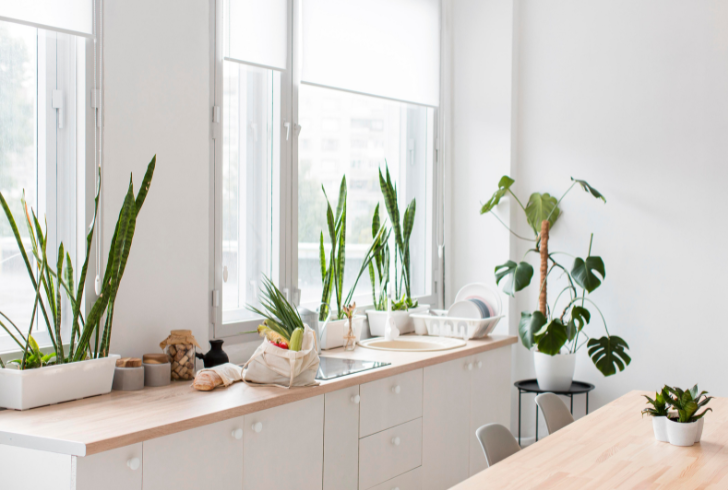Look up in most kitchens and you’ll find a slim gap between the cabinets and the ceiling—a no-man’s land where dust gathers and energy stalls. In feng shui, that empty space isn’t just decorative; it can block the smooth movement of chi, dulling the atmosphere without you even realizing it.
The kitchen, according to feng shui, represents nourishment and emotional balance—it’s where energy feeds both body and spirit. When chi gets stuck, the space can start to feel heavy or lifeless. A simple fix? Bring nature in. Adding plants above the cabinets reintroduces movement and harmony, letting fresh energy circulate through the room.
How Greenery Elevates Chi and Mood

Freepik | Green plants lift the mood and invite calm energy that refreshes the entire kitchen space.
Interior designer Brandy Rinehart of Rinehart Design Group Inc. explains, “The kitchen represents prosperity and wellness, so maintaining an open, flowing energy here is essential. Plants soften the hard edges between the cabinetry and ceiling while encouraging chi to move upward.”
That upward lift of greenery does more than brighten the room—it lightens the mood. Shades of green, tied to renewal and growth, have a quiet way of restoring focus and easing the mind. In a kitchen where people gather to cook, talk, or sip coffee, this subtle color energy helps balance activity with calm.
Rinehart explains that live plants carry vitality in a way artificial ones cannot. “Real plants bring breath and movement to a home,” she says. “They act as gentle companions, keeping the atmosphere alive and fluid.”
Choosing the Right Plants for Above-Cabinet Spaces
Not every plant can thrive high up near the ceiling. In feng shui, placement matters—plants should match the nature of their surroundings. Those chosen for shaded or hard-to-reach spots should be hardy, forgiving, and naturally vibrant.
Rinehart suggests a few reliable choices:
Pothos – Trails softly downward, adding movement that smooths harsh lines.
Spider Plant – Filters air and circulates uplifting, clean energy.
ZZ Plant – Thrives with little light or attention, adding depth to tall shelves.
Philodendron – Offers timeless green foliage that complements any design style.
Each plant brings its own gentle rhythm, restoring flow where energy tends to stagnate. It’s best to skip cacti or spiky species, which can introduce sharp, restless energy into a nurturing space.
Creating an Intentional Design
Placement matters as much as the plants themselves. Leave enough space between each pot so the display feels airy and deliberate, not crowded. This intentional spacing allows energy to flow freely while providing the eye with moments of rest.
A coordinated mix of textures and tones, matte ceramics, glass vases, or woven baskets, adds warmth and character. It’s best to keep the visual story cohesive yet relaxed, blending greenery into the overall kitchen design instead of making it a focal point.
Lighting also influences how plants perform and how chi moves. Rinehart advises layering light: use soft, warm bulbs under the cabinets and subtle ceiling fixtures to maintain a cozy, even glow throughout the space.
Daily Rituals that Sustain Harmony
Bringing plants into the kitchen is only the first step; caring for them is what keeps their energy alive. Watering, pruning, or simply noticing a new sprout turns upkeep into mindfulness. Each small act of care strengthens your connection with the space, inviting calm and quiet balance.
Feng shui consultant Rinehart often reminds clients that the practice is more than visual harmony. “It’s not about creating perfection—it’s about keeping energy in motion through small, steady habits,” she says. Simple routines—clearing countertops, wiping the stove, or adjusting lighting—help maintain a sense of vitality in the kitchen.
Even the act of opening a window while cooking or wiping down surfaces at night helps renew the flow of energy. Combined with greenery, these gestures turn the kitchen into a living environment that nourishes from within.
Herbs and Edible Plants Add a Functional Touch

Freepik | Herbs infuse the kitchen with both freshness and intention, grounding everyday routines in care.
For those who love to cook, growing herbs near the sink or stove marries practicality with feng shui wisdom. Varieties like rosemary, thyme, and oregano don’t just enhance dishes—they symbolize renewal and abundance.
Placed near a sunny window, they thrive. Each time you water or trim them, you set chi in motion again, keeping the room’s energy active and uplifting.
Watering or trimming them becomes more than upkeep; it’s a way of renewing connection and balance. This quiet partnership between design and care reflects feng shui’s heart: harmony through daily interaction.
Living Energy, Lasting Balance
Over time, the flow created by greenery and herbs becomes its own rhythm. The kitchen feels balanced, grounded, and alive.
Even everyday acts—boiling water, brewing tea, tidying counters—carry movement and flow. When energy circulates freely, the space feels centered, alive, and quietly restorative.








